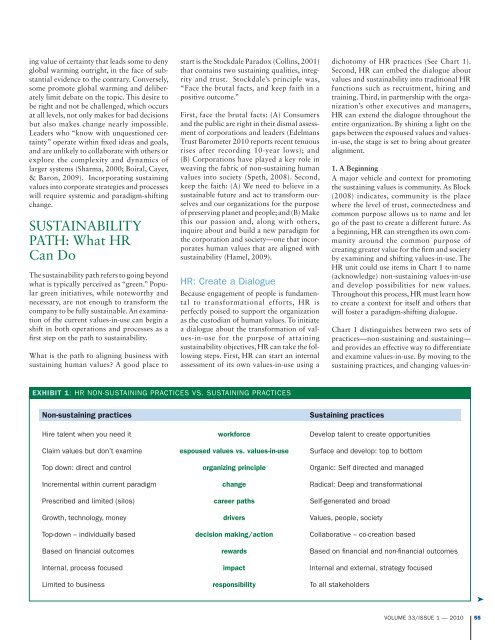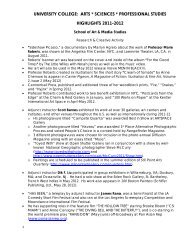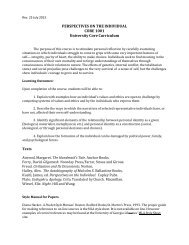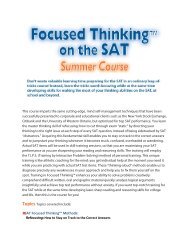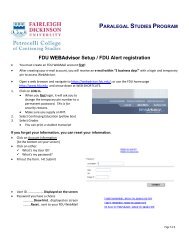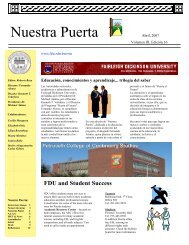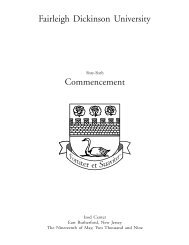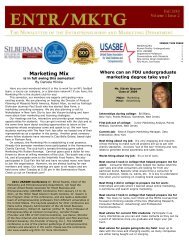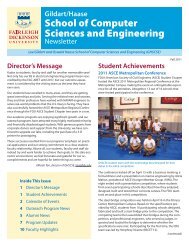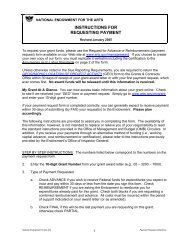Can Green Swim Upstream? - FDU
Can Green Swim Upstream? - FDU
Can Green Swim Upstream? - FDU
You also want an ePaper? Increase the reach of your titles
YUMPU automatically turns print PDFs into web optimized ePapers that Google loves.
ing value of certainty that leads some to deny<br />
global warming outright, in the face of substantial<br />
evidence to the contrary. Conversely,<br />
some promote global warming and deliberately<br />
limit debate on the topic. This desire to<br />
be right and not be challenged, which occurs<br />
at all levels, not only makes for bad decisions<br />
but also makes change nearly impossible.<br />
Leaders who “know with unquestioned certainty”<br />
operate within fixed ideas and goals,<br />
and are unlikely to collaborate with others or<br />
explore the complexity and dynamics of<br />
larger systems (Sharma, 2000; Boiral, Cayer,<br />
& Baron, 2009). Incorporating sustaining<br />
values into corporate strategies and processes<br />
will require systemic and paradigm-shifting<br />
change.<br />
SUSTAINABILITY<br />
PATH: What HR<br />
<strong>Can</strong> Do<br />
The sustainability path refers to going beyond<br />
what is typically perceived as “green.” Popular<br />
green initiatives, while noteworthy and<br />
necessary, are not enough to transform the<br />
company to be fully sustainable. An examination<br />
of the current values-in-use can begin a<br />
shift in both operations and processes as a<br />
first step on the path to sustainability.<br />
What is the path to aligning business with<br />
sustaining human values? A good place to<br />
start is the Stockdale Paradox (Collins, 2001)<br />
that contains two sustaining qualities, integrity<br />
and trust. Stockdale’s principle was,<br />
“Face the brutal facts, and keep faith in a<br />
positive outcome.”<br />
First, face the brutal facts: (A) Consumers<br />
and the public are right in their dismal assessment<br />
of corporations and leaders (Edelmans<br />
Trust Barometer 2010 reports recent tenuous<br />
rises after recording 10-year lows); and<br />
(B) Corporations have played a key role in<br />
weaving the fabric of non-sustaining human<br />
values into society (Speth, 2008). Second,<br />
keep the faith: (A) We need to believe in a<br />
sustainable future and act to transform ourselves<br />
and our organizations for the purpose<br />
of preserving planet and people; and (B) Make<br />
this our passion and, along with others,<br />
inquire about and build a new paradigm for<br />
the corporation and society—one that incorporates<br />
human values that are aligned with<br />
sustainability (Hamel, 2009).<br />
HR: Create a Dialogue<br />
Because engagement of people is fundamental<br />
to transformational efforts, HR is<br />
perfectly poised to support the organization<br />
as the custodian of human values. To initiate<br />
a dialogue about the transformation of values-in-use<br />
for the purpose of attaining<br />
sustainability objectives, HR can take the following<br />
steps. First, HR can start an internal<br />
assessment of its own values-in-use using a<br />
ExHIBIT 1: HR NON-SUSTAINING PRACTICES VS. SUSTAINING PRACTICES<br />
Non-sustaining practices Sustaining practices<br />
dichotomy of HR practices (See Chart 1).<br />
Second, HR can embed the dialogue about<br />
values and sustainability into traditional HR<br />
functions such as recruitment, hiring and<br />
training. Third, in partnership with the organization’s<br />
other executives and managers,<br />
HR can extend the dialogue throughout the<br />
entire organization. By shining a light on the<br />
gaps between the espoused values and valuesin-use,<br />
the stage is set to bring about greater<br />
alignment.<br />
1. A Beginning<br />
A major vehicle and context for promoting<br />
the sustaining values is community. As Block<br />
(2008) indicates, community is the place<br />
where the level of trust, connectedness and<br />
common purpose allows us to name and let<br />
go of the past to create a different future. As<br />
a beginning, HR can strengthen its own community<br />
around the common purpose of<br />
creating greater value for the firm and society<br />
by examining and shifting values-in-use. The<br />
HR unit could use items in Chart 1 to name<br />
(acknowledge) non-sustaining values-in-use<br />
and develop possibilities for new values.<br />
Throughout this process, HR must learn how<br />
to create a context for itself and others that<br />
will foster a paradigm-shifting dialogue.<br />
Chart 1 distinguishes between two sets of<br />
practices—non-sustaining and sustaining—<br />
and provides an effective way to differentiate<br />
and examine values-in-use. By moving to the<br />
sustaining practices, and changing values-in-<br />
Hire talent when you need it workforce Develop talent to create opportunities<br />
Claim values but don’t examine espoused values vs. values-in-use Surface and develop: top to bottom<br />
Top down: direct and control organizing principle Organic: Self directed and managed<br />
Incremental within current paradigm change Radical: Deep and transformational<br />
Prescribed and limited (silos) career paths Self-generated and broad<br />
Growth, technology, money drivers Values, people, society<br />
Top-down – individually based decision making/action Collaborative – co-creation based<br />
Based on financial outcomes rewards Based on financial and non-financial outcomes<br />
Internal, process focused impact Internal and external, strategy focused<br />
Limited to business responsibility To all stakeholders<br />
➤<br />
VOLUME 33/ISSUE 1 — 2010 55


